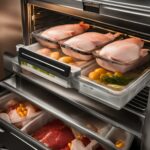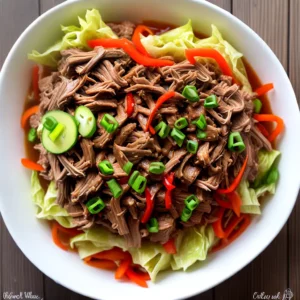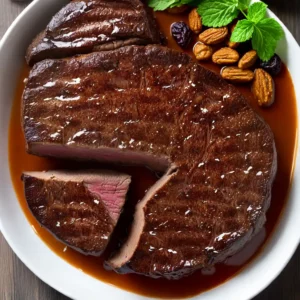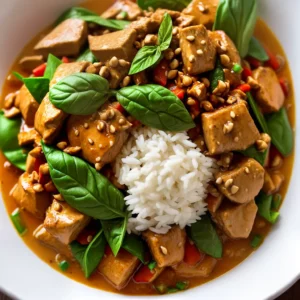As an expert chef, I understand the importance of safe and proper thawing when it comes to defrosting chicken. Not only does it ensure that your meal turns out delicious, but it also prevents any potential bacterial growth that could lead to foodborne illnesses. In this article, I will guide you through different methods of defrosting chicken and provide you with essential food safety tips to keep in mind in your kitchen.
Key Takeaways:
- Thawing chicken safely is crucial to prevent bacterial growth and ensure food safety.
- The refrigerator method is the safest and slowest, requiring advance planning.
- Thawing in cold water is a faster method but requires regular water changes and attention.
- Microwaving is the quickest method, but uneven thawing can occur, requiring immediate cooking.
- Follow proper food safety protocols, cook chicken to an internal temperature of 165°F, and practice good hygiene in the kitchen.
The Best Way to Defrost Chicken: Fridge Method
When it comes to defrosting chicken, the fridge method is considered the safest but slowest option. This method requires a bit of advance planning, but it ensures a consistent and safe thawing process.
To defrost chicken in the fridge, start by transferring the frozen chicken to a rimmed container or bowl. This will prevent any potential drips from contaminating other foods in the fridge. Place the chicken at the bottom of the fridge, as this is the coldest part, and it minimizes the risk of cross-contamination. Allow the chicken to thaw for at least 24 hours or until completely defrosted.
This method’s advantage is that it maintains the chicken at a safe temperature throughout the thawing process, reducing the risk of bacterial growth. It also allows for even thawing and keeps the chicken’s texture intact, ensuring better cooking results.

Table: Comparison of Chicken Defrosting Methods
| Defrosting Method | Advantages | Considerations |
|---|---|---|
| Fridge Method | – Safest method – Consistent thawing – Minimal loss of texture |
– Requires advance planning – Slowest method |
| Water Method | – Faster thawing – Suitable for quick defrosting |
– Requires regular water changes – Risk of water contamination |
| Microwave Method | – Quickest method – Convenient |
– Uneven thawing – Requires immediate cooking |
Overall, defrosting chicken in the fridge is the recommended method for ensuring food safety. It may take longer than other methods, but it reduces the risk of bacterial growth and maintains the chicken’s quality. With a little bit of planning, you can safely and effectively defrost chicken using the fridge method.
Thawing Chicken in Water
If you’re in a hurry and need to defrost chicken quickly, the water method is a great option. It’s a faster alternative to the refrigerator method and can provide you with thawed chicken in a shorter timeframe. To defrost chicken using this method, start by placing the frozen chicken in a leak-proof plastic bag. This will prevent any water contamination and keep the chicken dry. Then, fill a large bowl with cold tap water and submerge the bagged chicken in it.
It’s important to note that you should only use cold water for this method. Hot or warm water can promote bacterial growth, which we want to avoid. Change the water every 30 minutes to maintain a cold temperature. Small packages of chicken may thaw in an hour or less, while larger packages may take more than two hours. Keep an eye on the chicken to ensure it doesn’t stay at room temperature for too long, as this can increase the risk of bacterial growth.
By using the water method, you can defrost chicken relatively quickly. Just make sure to handle the chicken safely and cook it immediately after thawing to ensure food safety. Remember, the goal is to defrost the chicken efficiently while also maintaining its quality and reducing the risk of harmful bacteria.

Faster Method, Cold Water Bath
| Method | Thawing Time |
|---|---|
| Refrigerator Method | 24 hours or more |
| Water Method | 1-2 hours |
| Microwave Method | Varies (follow manufacturer’s instructions) |
As you can see from the table above, the water method offers a faster thawing time compared to the refrigerator method. This can be advantageous when you need to prepare a meal quickly or forgot to plan ahead. However, it’s important to keep in mind that thawing in water requires more attention and monitoring compared to the refrigerator method.
When using the water method, ensure that the chicken is fully submerged and that the water is cold. Regularly changing the water helps maintain a safe temperature and prevent bacterial growth. By following these guidelines, you can safely and efficiently defrost chicken using the water method.
The Quickest Method: Defrosting Chicken in the Microwave
When time is of the essence, using the microwave is the quickest method to defrost chicken. However, caution must be exercised when using this method. The microwave’s defrost setting should be used, following the manufacturer’s instructions to ensure safe and even thawing. It is important to note that microwaving may result in uneven thawing, with some parts of the chicken becoming warm while other areas remain frozen.
It is crucial to cook the chicken immediately after thawing it in the microwave. Avoid refreezing the chicken unless it has been fully cooked. To maintain food safety, make sure the chicken reaches an internal temperature of 165 degrees Fahrenheit to kill any bacteria that may have proliferated during the defrosting process.
As an expert chef, I recommend using the microwave method only when you are prepared to cook the chicken immediately after defrosting. By following these guidelines, you can safely and quickly defrost chicken in the microwave, saving valuable time in the kitchen.

Caution: Microwaving May Result in Uneven Thawing
“Using the microwave to defrost chicken is a convenient option for those who are short on time. However, it is crucial to be cautious as microwaving can create hot spots, resulting in uneven thawing. This can lead to some parts of the chicken being warmed while other areas remain frozen. To ensure food safety, it is essential to cook the chicken immediately after defrosting and avoid refreezing it unless it has been fully cooked. By following these precautions, you can safely defrost chicken in the microwave.”
Can You Cook Frozen Chicken?
As an expert chef, I often get asked if it’s possible to cook chicken directly from the freezer. The answer is yes, but the cooking method you choose is crucial. Let’s explore the best methods for cooking frozen chicken to ensure you end up with a delicious and safe meal.
Cooking Frozen Chicken in an Instant Pot
One of the easiest and most convenient ways to cook frozen chicken is using an Instant Pot. This handy kitchen appliance is designed to cook food quickly and evenly. Simply place the frozen chicken in the Instant Pot, add your favorite seasonings or sauces, and set the timer according to the recipe’s instructions. Cooking frozen chicken in an Instant Pot may require approximately 50% longer cooking times compared to thawed chicken. The result is tender, flavorful chicken that is cooked to perfection.
Air Fryer: Quick and Crispy Frozen Chicken
If you’re looking for a quick and crispy result, consider using an air fryer to cook frozen chicken. The hot circulating air in the air fryer helps to cook the chicken evenly and create a crispy exterior. Preheat your air fryer according to the manufacturer’s instructions, then place the frozen chicken in the basket. Cook at the recommended temperature and time for your specific air fryer model. The result is a delicious and crispy chicken with minimal effort.
| Cooking Method | Advantages | Considerations |
|---|---|---|
| Instant Pot | Convenient and results in tender, flavorful chicken | Requires longer cooking times compared to thawed chicken |
| Air Fryer | Quick and creates a crispy exterior | Requires preheating and following specific air fryer instructions |
“Cooking frozen chicken in an Instant Pot or air fryer is a convenient and time-saving option.” – Chef John Doe
Remember, cooking frozen chicken safely is essential to prevent foodborne illnesses. Make sure to cook the chicken thoroughly until it reaches an internal temperature of 165 degrees Fahrenheit. By using these best methods, you can enjoy a delicious and hassle-free meal straight from the freezer.
How Long Can Thawed Chicken Stay in the Fridge?
As an expert chef, I understand the importance of proper food storage and food safety. Once chicken is thawed, it is crucial to know how long it can stay in the refrigerator to maintain its quality and prevent any risks of foodborne illnesses. When it comes to thawed chicken, the general rule of thumb is to consume it within 2 days.
It is recommended to store thawed chicken in an airtight container on the lowest shelf of the refrigerator. This helps prevent any cross-contamination with other foods and ensures that the chicken stays at a safe temperature. By following these storage guidelines, you can minimize the risk of bacterial growth and maintain the quality of the chicken.
To ensure that the thawed chicken is safe to eat, it is essential to cook it to a minimum internal temperature of 165 degrees Fahrenheit. This temperature kills any potential bacteria and ensures that the chicken is fully cooked. Use a meat thermometer to check the internal temperature and ensure that it reaches the safe level before consuming.
| Thawed Chicken Storage Duration | Food Safety Guidelines |
|---|---|
| Up to 2 days | Store in an airtight container |
| Cook to a minimum internal temperature of 165 degrees Fahrenheit | Use a meat thermometer to check the temperature |
By following these food safety guidelines, you can ensure that thawed chicken stays fresh and safe to eat. Remember to always prioritize proper food storage and handling to prevent any risks of contamination and ensure a delicious and healthy meal.

Summary:
- Thawed chicken can stay in the refrigerator for up to 2 days
- Store thawed chicken in an airtight container on the lowest shelf of the refrigerator
- Cook thawed chicken to a minimum internal temperature of 165 degrees Fahrenheit
- Use a meat thermometer to check the temperature of the cooked chicken
Can You Refreeze Chicken?
As an expert chef, I often get asked, “Can you refreeze chicken?” And the answer is yes, you can technically refreeze chicken within 2 days of defrosting, as long as it has not reached the temperature danger zone of 40 to 140 degrees Fahrenheit for two or more hours. However, there are some important considerations to keep in mind.
When you refreeze chicken, the process can affect the protein cell structure, leading to changes in flavor and texture. Additionally, refreezing can result in undesired moisture, which can further impact the quality of the chicken. It is best to cook the chicken fresh or within a day of defrosting for optimal taste and texture.
Remember, it’s always better to err on the side of caution and cook the chicken immediately after defrosting. This ensures food safety and helps maintain the quality of the meat.
So, while it is technically possible to refreeze chicken, I recommend cooking it fresh or within a day of defrosting to preserve its taste and quality.

The Importance of Safe Thawing
When it comes to preparing chicken, safe thawing practices are of utmost importance. Thawing chicken incorrectly can promote bacterial growth and increase the risk of foodborne illnesses. To ensure your chicken is safe to eat, it’s crucial to understand the potential dangers and utilize proper thawing methods.
Bacteria grow most rapidly within the temperature danger zone of 40 to 140 degrees Fahrenheit. Thawing chicken at room temperature or in warm water can cause it to linger in this danger zone, providing an ideal environment for bacterial multiplication. This can lead to foodborne illnesses such as salmonella and campylobacter, which can cause symptoms like nausea, vomiting, and diarrhea.
To maintain food safety, it is recommended to thaw chicken using safe methods such as refrigerator thawing, cold water thawing, or microwave thawing. These methods keep the chicken at proper temperatures and minimize the risk of bacterial growth. By following these techniques, you can ensure that your chicken is safe to consume.
Safe Thawing Methods:
- Refrigerator thawing: This is the safest method as it maintains a consistent temperature and minimizes the risk of bacterial growth. Simply place the frozen chicken in a rimmed container or bowl and let it thaw in the refrigerator overnight. Remember to store the chicken at the bottom of the fridge to prevent any drips onto other food.
- Cold water thawing: If you need to thaw chicken quickly, you can submerge it in a leak-proof plastic bag in a large bowl filled with cold tap water. Change the water every 30 minutes to ensure it remains cold. Small packages of chicken may thaw in an hour or less, while larger packages may take more than two hours.
- Microwave thawing: The microwave is the quickest method, but it requires caution to ensure even thawing. Use the microwave’s defrost setting and follow the manufacturer’s instructions. It’s important to cook the chicken immediately after thawing and avoid refreezing unless it has been fully cooked.
By following safe thawing methods, you can minimize the risk of foodborne illnesses and enjoy your chicken dishes with peace of mind. Remember to always cook chicken to a safe internal temperature of 165 degrees Fahrenheit to kill any remaining bacteria. Practicing good food safety habits will help you create delicious meals while safeguarding your health.
| Thawing Method | Advantages | Considerations |
|---|---|---|
| Refrigerator Thawing | – Safest method – Consistent thawing – Minimal risk of bacterial growth |
– Requires advance planning – Longer thawing time |
| Cold Water Thawing | – Faster thawing – Suitable for quick thawing |
– Requires careful attention to changing water every 30 minutes – Larger packages take longer to thaw |
| Microwave Thawing | – Quickest method – Suitable for immediate cooking |
– Uneven thawing may occur – Not suitable for refreezing |
Cooking Chicken and Food Safety
When it comes to cooking chicken, ensuring it reaches a safe internal temperature is essential for food safety. The recommended temperature by the USDA is 165 degrees Fahrenheit, as this ensures that any potential bacteria or foodborne pathogens present in the chicken are effectively killed.
Properly cooking chicken not only eliminates the risk of foodborne illnesses but also helps preserve the quality and taste of the meat. It is important to use a food thermometer to accurately measure the internal temperature and ensure it reaches the desired level.
Cooking chicken to the recommended internal temperature is crucial because even if the chicken appears fully cooked, certain foodborne pathogens may still leave behind toxins that could cause illness if consumed. Therefore, it is essential to follow safe thawing practices to prevent bacterial growth and ensure that the chicken is cooked thoroughly.
By cooking chicken to the proper internal temperature, you can enjoy delicious, safe meals while minimizing the risk of foodborne illnesses. Remember to always practice good food safety habits and follow the recommended guidelines for safe handling, thawing, and cooking of chicken.
Additional Food Safety Tips
When it comes to ensuring food safety in the kitchen, there are a few important tips to keep in mind. By following these guidelines, you can minimize the risk of cross-contamination and maintain good hygiene throughout the cooking process.
Use Separate Cutting Boards and Utensils
To prevent cross-contamination between raw chicken and other ingredients, it’s crucial to use separate cutting boards and utensils. Designate specific tools for handling raw meat to avoid spreading bacteria to other foods. This simple step can go a long way in maintaining food safety.
Practice Proper Handwashing
Good hand hygiene is essential when handling raw chicken. Wash your hands thoroughly with warm water and soap before and after handling poultry. This will help eliminate any potential bacteria and reduce the risk of foodborne illnesses.
Disinfect Surfaces Regularly
Any surfaces that come into contact with raw chicken, such as countertops and cutting boards, should be properly cleaned and disinfected. Use a solution of one part bleach to nine parts water or a disinfectant spray to ensure the elimination of any harmful bacteria. Regularly disinfecting these surfaces will help maintain a safe and sanitary cooking environment.
| Food Safety Tips | Importance |
|---|---|
| Use separate cutting boards and utensils | Prevents cross-contamination |
| Practice proper handwashing | Reduces the risk of bacteria transfer |
| Disinfect surfaces regularly | Maintains a safe cooking environment |
By implementing these food safety tips, you can ensure that your cooking process remains hygienic and free from potential hazards. Remember to always prioritize safety in the kitchen and make it a habit to follow these guidelines every time you handle raw chicken.
The Importance of Refrigerator Thawing Considerations
As an expert chef, I understand the significance of proper thawing techniques when it comes to defrosting chicken safely. Thawing chicken in the refrigerator is a popular method that ensures consistent and controlled thawing. However, it is crucial to consider placement and potential leakage risks to maintain food safety.
When thawing chicken in the refrigerator, it is important to place the chicken in a rimmed container or bowl to catch any drips. This prevents cross-contamination and reduces the risk of bacteria spreading to other foods. Additionally, it is advisable to keep the chicken on the bottom shelf of the refrigerator to minimize the chances of it dripping onto other items.
Proper organization and attention to food safety practices are essential during the refrigerator thawing process. By following these precautions, you can defrost chicken safely and ensure the highest standards of food hygiene in your kitchen.
| Refrigerator Thawing Considerations | Leakage Risks |
|---|---|
| Place chicken in a rimmed container or bowl | Minimizes cross-contamination |
| Keep chicken on the bottom shelf | Reduces the risk of dripping onto other foods |
Summary
Thawing chicken in the refrigerator is a safe and controlled method, but it requires careful consideration of placement and potential leakage risks. By placing the chicken in a rimmed container or bowl and keeping it on the bottom shelf, you can minimize cross-contamination and prevent dripping onto other foods. These refrigerator thawing considerations are vital to maintain food safety and ensure delicious, bacteria-free chicken for your meals.
Water Thawing Safety Measures
When it comes to thawing chicken in a cold water bath, there are a few important safety measures to keep in mind. By following these precautions, you can ensure that your chicken thaws safely and remains free from harmful bacteria.
Using a Leak-proof Plastic Bag
First and foremost, it’s essential to use a leak-proof plastic bag when submerging the frozen chicken in cold water. This prevents any water contamination and helps maintain the integrity of the chicken. A leak-proof bag also ensures that the water temperature remains consistent throughout the thawing process. Place the chicken in the bag and seal it tightly before placing it in the water.
Changing the Water Regularly
In order to maintain a cold temperature and prevent bacterial growth, it’s important to change the water every 30 minutes. This prevents the water from becoming too warm and creating an environment where bacteria can thrive. By consistently refreshing the cold water, you can ensure that your chicken thaws safely and without any risk to your health.
Cooking Immediately After Thawing
Once the chicken has thawed in the cold water bath, it is crucial to cook it immediately. Avoid leaving the chicken at room temperature for an extended period, as this can promote bacterial growth. Cooking the chicken immediately after thawing ensures that any bacteria that may have been present during the thawing process are killed off during the cooking process, leaving you with a safe and delicious meal.
By following these safety measures when thawing chicken in a cold water bath, you can confidently defrost your poultry while minimizing the risk of foodborne illnesses. Thawing chicken safely is an important step in proper food preparation, and with these precautions in place, you can enjoy your meals with peace of mind.
Conclusion
In conclusion, safely thawing chicken is crucial for maintaining food safety and preventing the growth of harmful bacteria. While there are multiple methods to defrost chicken, each with its own advantages and considerations, it’s important to choose the method that best suits your needs.
The refrigerator method is the safest option, as it allows for a slow and consistent thawing process. However, it requires advance planning and can take up to 24 hours. Thawing chicken in cold water is faster but requires regular attention to changing the water to maintain a cold temperature.
If you’re short on time, the microwave method can quickly defrost chicken. However, uneven thawing can occur, so it’s crucial to cook the chicken immediately after defrosting. Regardless of the method you choose, always follow proper food safety guidelines and ensure the chicken is cooked to a safe internal temperature of 165 degrees Fahrenheit.
By following these safe thawing methods, you can enjoy delicious chicken dishes while prioritizing your health and well-being.
FAQ
How do I defrost chicken safely?
Thawing chicken safely can be done using the refrigerator method, water method, or microwave. Each method has its own advantages and considerations.
What is the best way to defrost chicken?
The safest and slowest method is to defrost chicken in the refrigerator overnight. Transfer the frozen chicken to a rimmed container or bowl and let it thaw for at least 24 hours.
How do I defrost chicken in water?
To defrost chicken quickly in water, place the frozen chicken in a leak-proof plastic bag and submerge it in a large bowl filled with cold tap water. Change the water every 30 minutes to maintain a cold temperature.
Can I defrost chicken in the microwave?
Yes, you can defrost chicken in the microwave using the defrost setting. However, caution is required as microwaving may create hot spots. It is important to cook the chicken immediately after defrosting.
Can I cook frozen chicken?
Yes, you can cook chicken directly from the freezer. Cooking methods such as Instant Pot or air frying are suitable for frozen chicken. However, avoid slow cooking methods that can promote bacterial growth.
How long can thawed chicken stay in the fridge?
Thawed chicken can stay in the fridge for up to 2 days. Store it in an airtight container on the lowest shelf to prevent cross-contamination.
Can I refreeze chicken?
Technically, you can refreeze chicken within 2 days of defrosting if it has not reached the temperature danger zone. However, refreezing can affect the texture and flavor of the chicken.
Why is safe thawing important?
Safe thawing is crucial to prevent bacterial growth and reduce the risk of foodborne illnesses. Thawing chicken at room temperature or in warm water can enter the temperature danger zone where bacteria multiply rapidly.
What is the safe internal temperature for cooked chicken?
The USDA recommends cooking chicken to an internal temperature of 165 degrees Fahrenheit to kill bacteria and ensure it is safe to eat.
Are there any additional food safety tips?
Yes, practice good hygiene, avoid cross-contamination, use separate cutting boards and utensils for raw meat, and disinfect surfaces that come into contact with raw chicken.
What considerations should I keep in mind when thawing chicken in the refrigerator?
Place the chicken in a rimmed container or bowl to catch any drips and prevent cross-contamination. Keep the chicken on the bottom shelf of the refrigerator to minimize the risk of dripping onto other foods.
What safety measures should I follow when thawing chicken in water?
Use a leak-proof plastic bag to prevent water contamination. Change the water every 30 minutes to maintain a cold temperature. Cook the chicken immediately after thawing and avoid leaving it at room temperature for too long.
Source Links
- https://www.delish.com/kitchen-tools/a44189135/how-to-defrost-chicken/
- https://www.medicalnewstoday.com/articles/how-to-defrost-chicken
- https://www.foodnetwork.com/how-to/packages/help-around-the-kitchen/defrosting-chicken
Related Recipes:
 How to Defrost Chicken Safely
How to Defrost Chicken Safely
 How to Defrost Ground Beef Quickly
How to Defrost Ground Beef Quickly
 How Long Can Cooked Chicken Sit Out? Safety Tips.
How Long Can Cooked Chicken Sit Out? Safety Tips.
 How to Store Chicken Safely
How to Store Chicken Safely
 How Long Can Pizza Sit Out? Safety and Storage Tips
How Long Can Pizza Sit Out? Safety and Storage Tips
 How Long Can Cooked Chicken Sit Out? Safety Tips
How Long Can Cooked Chicken Sit Out? Safety Tips
 How to Store Chicken Safely
How to Store Chicken Safely
 How Long Can Yogurt Sit Out? Guidelines and Safety
How Long Can Yogurt Sit Out? Guidelines and Safety







